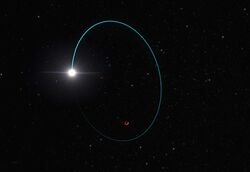Gaia BH3 facts for kids
| Observation data Epoch J2016.0 Equinox J2016.0 |
|
|---|---|
| Constellation | Aquila |
| Right ascension | 19h 39m 18.72s |
| Declination | +14° 55′ 54.2″ |
| Characteristics | |
| K2 star | |
| Evolutionary stage | K2 |
| Black hole | |
| Evolutionary stage | Stellar black hole |
| Astrometry | |
| Radial velocity (Rv) | -333.2 ±3.4 km/s |
| Proper motion (μ) | RA: -28.317 ±0.067 mas/yr Dec.: -155.221 ±0.111 mas/yr |
| Parallax (π) | 1.6933 ± 0.0164 mas |
| Distance | 1,930 ± 20 ly (591 ± 6 pc) |
| Orbit | |
| Period (P) | 4,253.1±98.5 d |
| Semi-major axis (a) | 16.17 ± 0.27 AU |
| Eccentricity (e) | 0.7291 ±0.0048 |
| Inclination (i) | 110.580 ±0.095° |
| Longitude of the node (Ω) | 136.236 ±0.128° |
| Periastron epoch (T) | JD, TCB 2458177.39 ± 0.88 |
| Argument of periastron (ω) (secondary) |
77.34 ±0.76° |
| Details | |
| K2 | |
| Mass | 0.76±0.05 M☉ |
| Radius | 4.936 ± 0.016 R☉ |
| Surface gravity (log g) | 2.929 ±0.003 cgs |
| Temperature | 5212 ±80 K |
| Metallicity [Fe/H] | -2.56 ± 0.11 dex |
| Black hole | |
| Mass | 32.70±0.82 M☉ |
| Other designations | |
|
Gaia BH3, 2MASS J19391872+1455542, Gaia DR3 4318465066420528000, LS II +14 13
|
|
| Database references | |
| SIMBAD | data |
Gaia BH3 (which is also called Gaia DR3 4318465066420528000) is a special pair of objects in space. It has two main parts: a K2 star and a stellar-mass black hole. A K2 star is a type of star that is cooler and smaller than our Sun. The black hole is a very dense object with super strong gravity.
This amazing system is about 1926 light years away from Earth. It is found in the constellation called Aquila, which looks like an eagle in the night sky. As of 2024, Gaia BH3 is the second-closest known black hole system to Earth. It also holds the record for being the heaviest known stellar black hole in our galaxy, the Milky Way.
What Makes Gaia BH3 Special?
The black hole in Gaia BH3 is incredibly massive. It weighs about 33 times the mass of our Sun. This makes it the heaviest stellar black hole ever found in the Milky Way galaxy.
The star and the black hole in Gaia BH3 orbit each other. They complete one full orbit around their shared center every 11.6 years. Their distance from each other changes during this orbit. It ranges from about 4.5 to 29 times the distance between the Earth and the Sun.
Gaia BH3 is one of only two known black holes in our galaxy that are much heavier than 10 times the Sun's mass. The other one is called Cygnus X-1. Scientists think that these very heavy black holes might form from stars that have very few heavy elements. The star in Gaia BH3 is indeed "metal-poor," which means it has fewer heavy elements. This discovery helps scientists understand how these giant black holes are made.
How Was Gaia BH3 Found?
Gaia BH3 was first spotted by the Gaia spacecraft in 2015. Gaia is a special telescope that measures the positions and movements of billions of stars. By carefully watching how the K2 star wobbled, scientists realized there had to be a very heavy, unseen object pulling on it.
The European Space Agency officially announced Gaia BH3 as a black hole system on April 16, 2024. This discovery was made possible by early information from Gaia's fourth set of data, called Gaia DR4.


